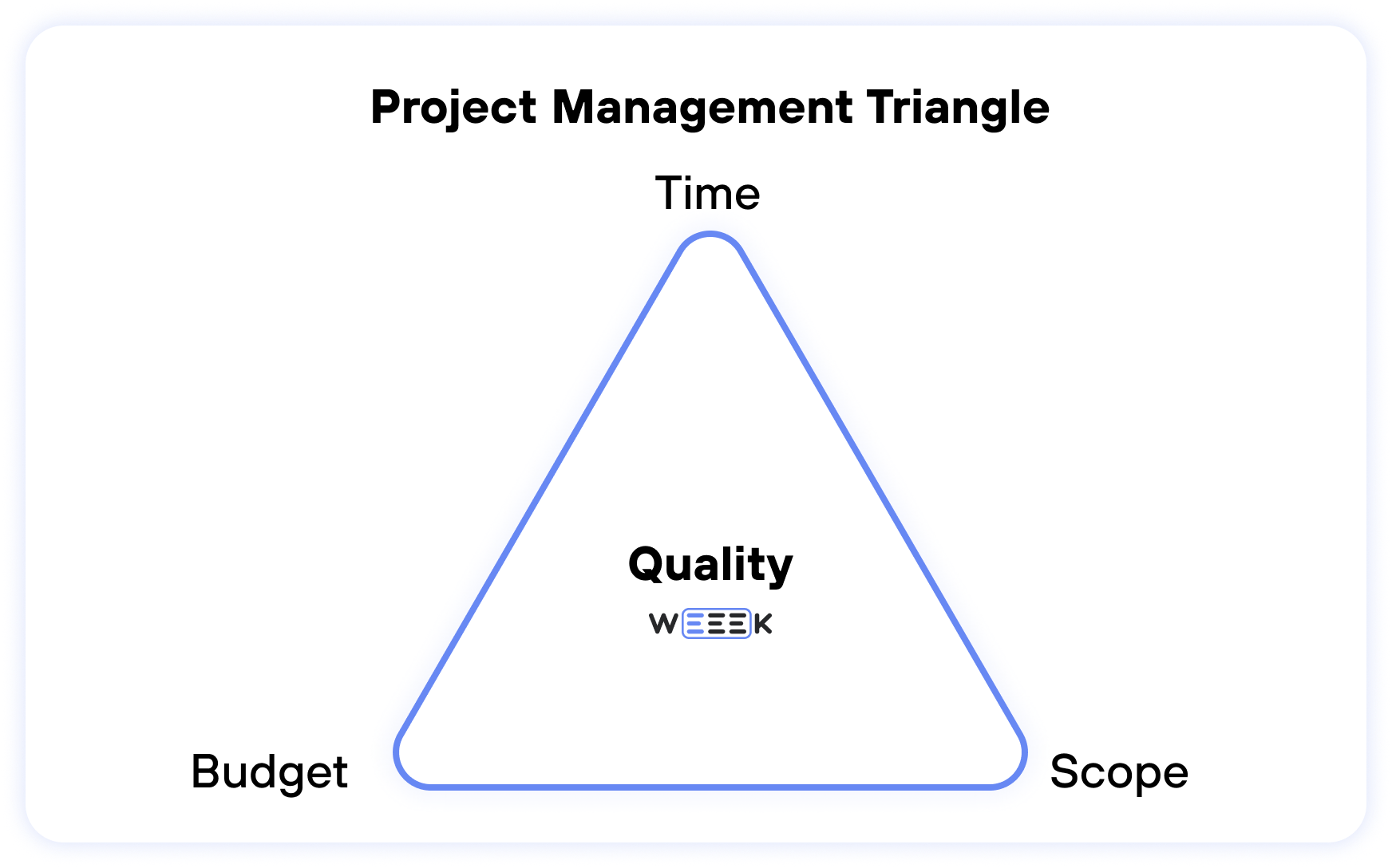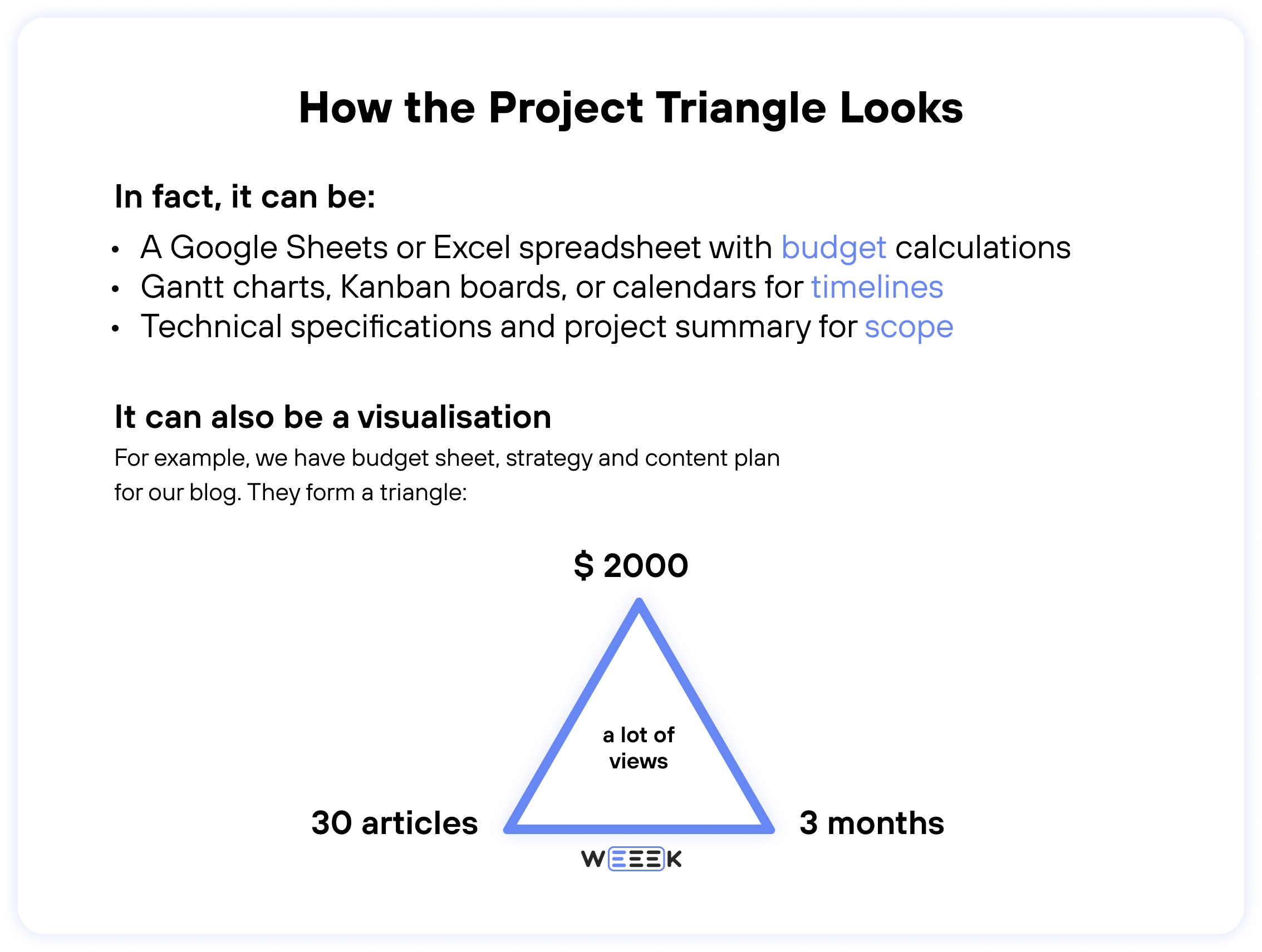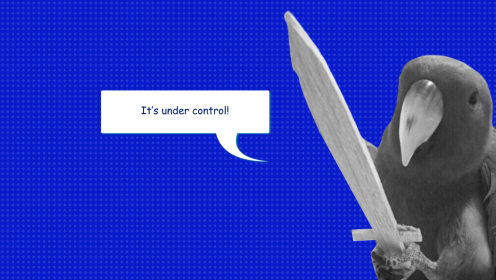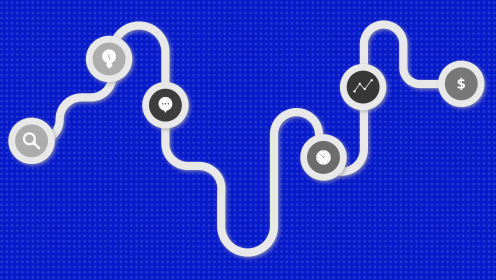Triangles are everywhere: in geometry, romantic relationships, and mystical symbols. In project management, a triangle connects three key variables: project scope, cost, and time. These elements are interdependent, and achieving a harmonious balance among them results in a high-quality outcome.
The main idea to remember is that you cannot change one of the three vertices of the project triangle without impacting the other two.
🔺 The project management triangle is a concept and metaphor in the field of project management. The sides of the triangle represent the constraints of any project, with quality positioned at the center.

Elements of the Project Triangle
Let's outline the elements of the project triangle:
- Scope = content, a set of specific tasks
- Time = deadlines, timelines
- Costs or resources = budget, people
- Quality = the standard of the final output
Scope
The project scope defines the size of the project in terms of detail and the magnitude of results.
It can be measured by summing up all actions leading to the final result or by considering only the major tasks. Detailed breakdowns of each task allow for a more accurate determination of the scope, which helps in calculating the necessary resources and time required for the project.
Dependency: The larger the scope of tasks, the more time and resources will be needed to complete them. This is a direct proportionality.
✅ It's ideal when both the executor and the client understand the complexity and scale of each step. This ensures that both parties speak the same language regarding the cost and time of the work. The concept of the project triangle can be a helpful reference in these discussions.
Time
Time is a crucial constraint for any project. Setting a deadline keeps the client from getting anxious and avoids making empty promises. Clearly defined timelines protect you from constant inquiries about the project's progress. Timelines are established through a project plan, which is based on the required scope and a detailed breakdown of each task.
Dependency: Time is directly proportional to scope and inversely proportional to budget. Therefore, reducing the budget or increasing the scope of work will require compensating by extending the timelines.
✅ Timelines should be realistic. You don't need to be a superhero; you just need to be a responsible person.
Cost
Money rules the world. Whatever is included in the project budget (human resources, tools, auxiliary means), payment ultimately boils down to monetary equivalents.
Dependency: Reducing the project cost will either require sacrificing scope or increasing time, assuming we want to maintain the quality of the result.
✅ When setting the budget, account for contingencies. Reserve an amount to cover potential losses.
Quality
Quality was added to the model after the three vertices and placed at the center. Quality is achieved when expectations meet reality, and this reality isn't always the client's. Sometimes it's necessary to objectively assess the client's requirements and explain that they won't lead to a high-quality result.
Dependency: Quality is directly related to the scope, budget, and time of the project. To improve project quality, you can increase the scope (more tasks need to be completed), extend the timelines (the project will take longer), or increase the budget (more resources will be invested).
✅ Don't set the quality bar too high. Find a balance where the project is beneficial and doesn't drain the team. The triangle model can help find this balance.
Interconnections Between the Triangle Components
The dependencies within the project management triangle can be summarized with two main rules.
- More Scope — More Time or Money — Better Quality
This is a direct relationship. Increasing the number of tasks requires a proportional increase in time and resources. The product will be of higher quality because more effort has been invested across the board.
- Less Time — Higher Cost, and vice versa
This inverse relationship assumes that the result and quality must remain unchanged. The concept is simple: the more workers you have, the less time they need to complete a task.
✅ These rules are immutable (even if the client insists otherwise). Changing any of the variables in the triangle will inevitably impact the other two. This is why the model is often referred to as the iron triangle—it cannot be bent without consequences.

How the Project Triangle Works in Agile, Scrum, Kanban, and Scrumban
Managing projects with the project triangle can be effectively combined with popular methodologies, with some adjustments and limitations.
We won't delve into Agile separately, as it’s more of a philosophy uniting various methodologies rather than a standalone method.
- In Scrum, where the project is divided into short intervals called sprints, you can use the triangle model for each sprint. Since time is already fixed, you only need to plan the scope and resources. Based on the results, you can adjust the model for the next sprint.
- On Kanban boards, the project triangle can be applied using WIP (Work In Progress) limits—constraints on the number of tasks in a column or the workload in hours. This way, you can manually limit the scope or time, keeping in mind your budget and resource capacities.
- In Scrumban, a hybrid of Scrum and Kanban, you can combine WIP limits with sprint planning using the project triangle model.
There's a methodology we insist on calling a concept—Waterfall. This predictive approach involves completing activities sequentially. Here, the project triangle is firmly established at the start and remains unchanged: the scope, timeframes, and budget are strictly fixed.
How the Project Triangle Looks
Not like a triangle 🙃
- Budget is best detailed in Google Sheets or Excel, where you can use formulas and compile several parameters across different tabs.
- Timeframes are most easily managed and controlled using Gantt charts, Kanban boards, or calendars.
- Scope is outlined in the project summary or a detailed technical specification.
- Quality is determined by the project goals and client requirements.
Thus, the real project triangle is a set of documents, tools, and data. It’s important to maintain and use these together.
While the geometric figure remains a concept and metaphor, you can visualize it for yourself, your team, and your client. This helps all project participants stay aligned and quickly understand the key information. On the vertices of the triangle, you can highlight the main project metrics—number of tasks, total budget, and final deadline.

Four Examples of Applying the Project Management Triangle
The Project Triangle in Development
The project management triangle is frequently used in IT. Here’s an example of how it works:
- 1. Define a requirement for an application or a proposal for its improvement.
- 2. Outline the actions needed to enhance the application's performance.
- 3. Calculate the cost of these actions and the implementation timeline.
- 4. If the client wants to release the update sooner (shorten the timeline), a decision must be made: either bring in more people and pay them (increase cost) or release the update without an additional feature (reduce scope).
- 5. This decision will have consequences: it might result in exceeding the budget or lowering the product quality by omitting a feature.
The Project Triangle in Freelancing
Consider a freelance photographer analyzing a content plan:
The photographer handles the task from start to finish: from concept and purchasing decorations to the actual shoot and photo editing. They limit the work by time, budget, and scope of tasks.
When adjusting one side, such as the budget, they might:
- Reduce the number of services provided—create fewer looks, purchase fewer props.
- Reduce time—shoot for one hour instead of two, edit fewer photos.
- Reduce quality—rush through the shots, resulting in less natural-looking props.
The Project Triangle in Advertising
Advertising production also relies on the project triangle.
Imagine a client decides to increase the scope of work mid-project—extending the duration of a commercial to include additional scenes.
The project manager needs to say "no" or ensure the client pays for the extra work. Increasing the scope requires either a larger budget or more time. Otherwise, the team would need to work overtime to meet deadlines, often without extra pay.
We advocate for healthy project management: either say no, or ensure extra work is compensated.
The Project Triangle in Everyday Life
Let's apply the concept to a typical workday. Here, two main variables are time and energy, which determine the amount of work you can accomplish.
Your time and energy are limited by the workday and your physical state. For instance, if you didn’t get enough sleep, your workday remains the same, but your energy levels will be lower.
To increase your workload, you could:
- Boost your energy by, for example, eating a candy bar. The sugar will give you a temporary energy boost.
- Extend your working hours by skipping lunch or working overtime. However, this has its drawbacks. Skipping meals can decrease your energy levels, and sitting in the office for 10 hours straight can also drain you.
Life is a bit more complex than the project triangle model. Don’t be too hard on yourself: resources are limited, and you're not a machine.
How to Manage the Project Triangle: Tips from WEEEK
- Maintain balance. Keep a balance between the three variables, considering your team’s capabilities.
- Assess risks. Don’t agree to change one of the vertices without evaluating the risks first. Remember their interconnections.
- Conduct regular reviews. Periodically review the triangle to keep processes up-to-date.
- Prioritize. Identify the most critical element of the triangle for the client and base your decisions on this priority.
- Adapt and experiment. Customize the triangle to fit your management style and don’t be afraid to experiment.
Summary for Busy Readers
-
The triangle model helps maintain a balance between time, cost, and scope without compromising quality
- The larger the scope of work, the more time and money are needed
- The less time available for a task, the more money will be required to complete it, and vice versa
- Any changes to one of the three variables will affect the other two
The triangle model can be used in various fields but don’t adhere to it too rigidly. Highlight what’s most useful, adapt it, and take control!
















